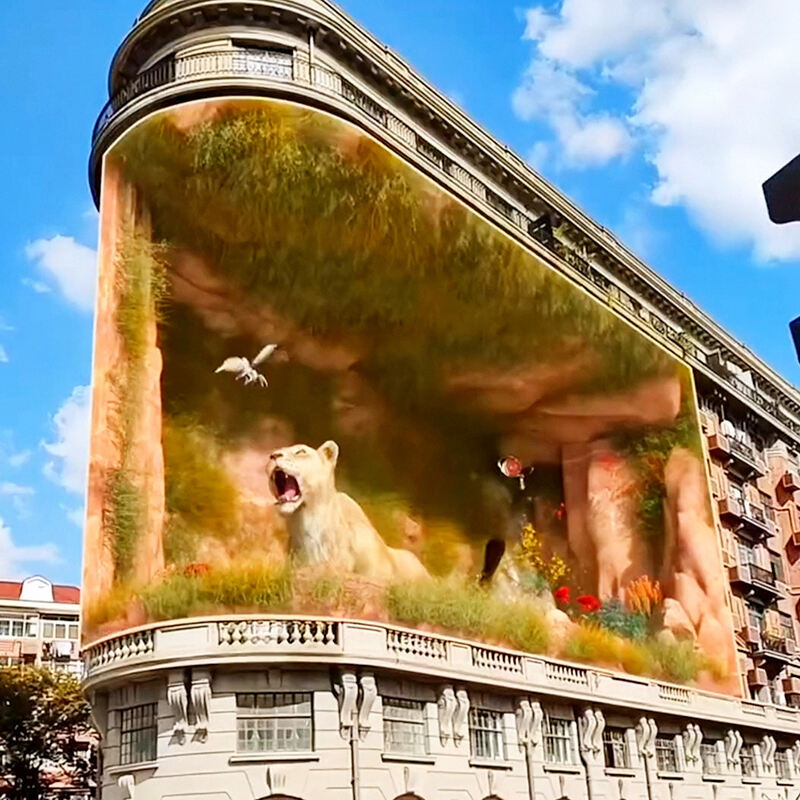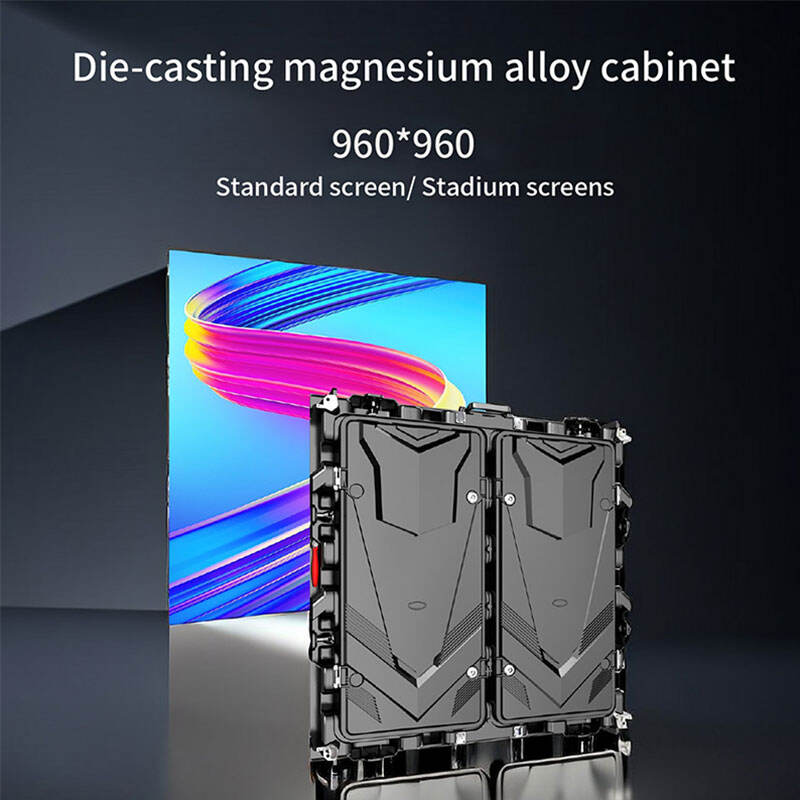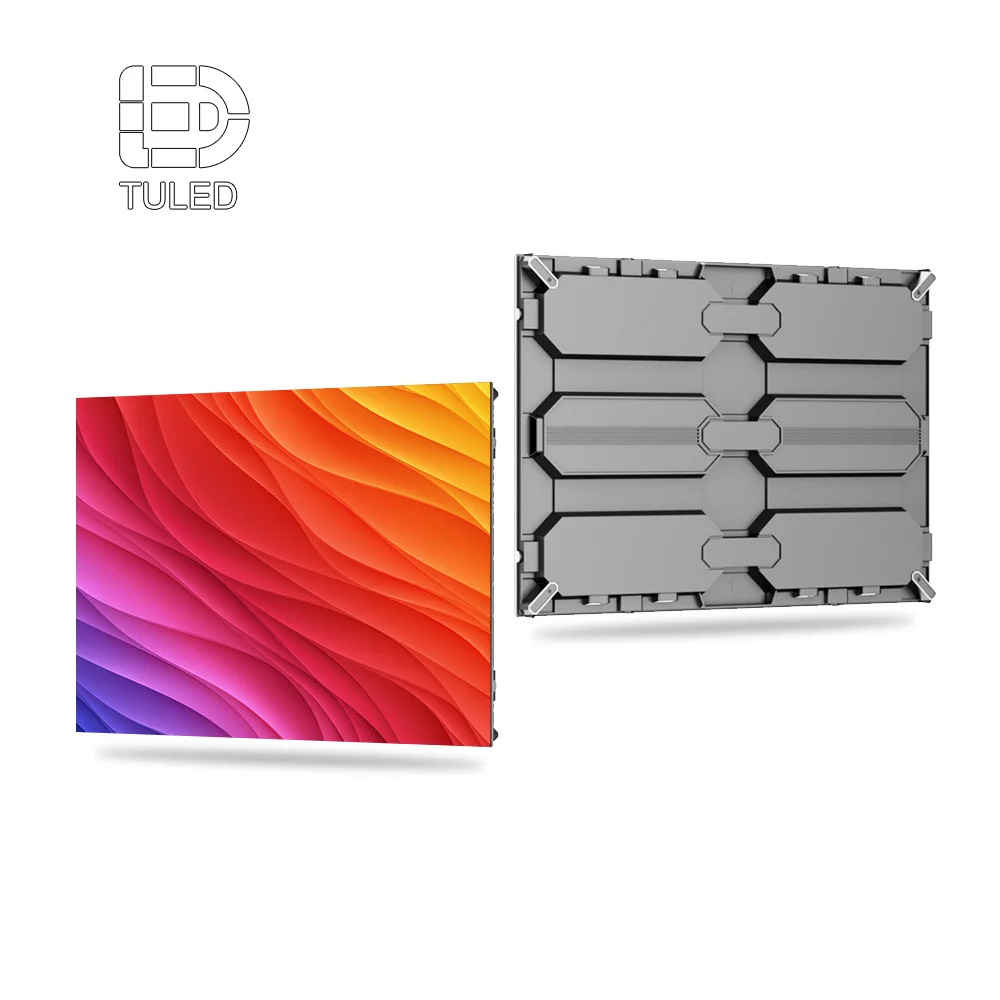Understanding the Core Components of an LED Display
Key Components: LED Modules, Power Supply, Controller Card, Cables, Frame
Modern LED displays integrate six essential elements: light-emitting modules, power infrastructure, control hardware, signal cables, structural framing, and protective cabinets. These systems require precise coordination among 200–500 individual components per square meter to deliver seamless visual performance.
LED Display Modules and Pixel Pitch Variations for Resolution Control
The spacing between individual LEDs, known as pixel pitch, plays a big role in determining both the resolution and how close someone needs to be to see details clearly. When we talk about something like a 2.5mm pitch, this allows for pretty sharp images similar to 4K at around 3 meters away, which works great for things like indoor production studios. On the other hand, those bigger 10mm pitches still let people read what's on screen from much farther distances, making them suitable for outside displays where viewers might be 30 meters away or more. Some of the top tier LED panels these days come equipped with 14-bit grayscale technology. What does that mean? Well, basically each pixel can handle over 16 thousand different shades of color. This leads to much smoother transitions between colors and overall better looking images when compared to older models.
Control System (Controller, Sending and Receiving Cards) Functionality
The control system uses a distributed processing setup that handles all those fast moving data signals across big screens. The sending cards take standard HDMI or DVI connections and turn them into UDP data streams. These get sent out through fiber optic lines or good old CAT6 cables to the receiving end cards. What's really impressive is how each receiving card manages between 1,024 and 4,096 different zones within a single module. They support refresh rates as high as 240Hz too, which makes sure there's no annoying motion blur when something moves quickly across the screen. This kind of performance matters a lot for things like sports broadcasts or action packed video content where clarity at speed is absolutely critical.
Power Supply Requirements for LED Displays Based on Size and Brightness
Power consumption scales significantly with brightness and environment:
- Indoor displays (1,500 nits): ~40W/m²
- Outdoor displays (7,500 nits): ~240W/m²
To maintain stable operation, modular power supplies provide ±1% voltage regulation, delivering 5V DC for indoor units and 48V DC for outdoor installations. This ensures consistent performance over cable runs exceeding 20 meters without significant voltage drop.
Cabinet Types for LED Display Assembly: Indoor vs. Outdoor Applications
The outdoor cabinets are made with IP65 rated extruded aluminum that has a 5mm thick wall designed to handle rain, dust, and even prolonged UV exposure without degrading over time. For indoor applications, manufacturers typically go with lighter gauge steel around 1.2mm thick and include front access panels so technicians can get into the system easily when maintenance is needed. Some of the newer advanced models actually combine different cooling methods depending on temperature conditions. Below 35 degrees Celsius, they rely on passive air movement through natural convection, but once temperatures rise higher than that, fans kick in to force additional airflow. This clever approach cuts down on overall power usage by approximately 18 percent as noted in last year's Thermal Management Industry Report from 2022.
Designing the LED Display Layout and Structural Framework
Step-by-Step Design Process for Optimal Screen Dimensions and Aspect Ratio
When setting up a display, start by figuring out what it needs to do and where people will actually be looking at it. Indoors? A 16:9 screen works best since most videos and presentations are made for that format anyway. Makes everything look right without weird stretching issues. Outdoors is different though. Those big screens usually go for something wider, maybe around 18:6 or similar, so folks can see them clearly even when standing far away. Don't forget about the hardware side either. Modeling cabinet layouts in CAD software helps check if the structure can handle all that weight properly. Safety first here, both for installation and keeping things aligned correctly over time.
Calculating Total LED Modules Needed Based on Pixel Pitch and Screen Size
To determine the number of modules required, divide the screen dimensions (in millimeters) by the pixel pitch. For a 4m × 2m display using 4mm pitch modules:
- Width: 4000mm ÷ 4mm = 1000 modules per row
- Height: 2000mm ÷ 4mm = 500 modules per column
-
Total: 1000 × 500 = 500,000 modules
This calculation ensures accurate procurement and layout planning.
Modular Layout Planning Using Cabinets for Scalability and Maintenance
Organize the display into standardized cabinet sections–typically 500×500mm or 1000×1000mm–to streamline assembly and servicing. Each cabinet houses 64–256 modules depending on pixel density and features interlocking mechanisms for precise alignment. This modular approach allows targeted repairs without dismantling the entire structure, minimizing downtime and operational disruption.
Assembling the LED Display Cabinet and Installing Modules
Step-by-Step Assembly Guide: Framing the Cabinet and Securing Mounting Rails
Building a sturdy frame requires using aluminum T-slot extrusions that fit the size of whatever display needs support. Vertical supports should be spaced within 16 inches of each other to keep things stable. When attaching those mounting rails, make sure to use fasteners that resist corrosion so everything stays aligned within about half a millimeter. If installing near the coast or somewhere really humid, consider switching to powder coated steel frames instead. Some field tests indicate aluminum tends to rust about three times quicker under these conditions, which can cause problems down the road if not addressed properly during installation.
Installing LED Modules With Precision Alignment and Secure Locking
When installing modules, always start at the top left corner of each cabinet. Use those magnetic brackets they provide because they really do make it easy to move things around again in just a couple of seconds flat. Now for connecting the modules themselves, we're talking about those classic tongue and groove edges. Once aligned, give those locking levers a good twist with around 12 to 15 Newton meters of torque to ensure proper sealing against dust getting inside. And don't forget about the spacing between panels either. Leave approximately 0.2 to 0.3 millimeters gap by inserting those little plastic spacers. This might seem like splitting hairs but trust me, it's essential when dealing with temperature fluctuations from minus 30 degrees Celsius all the way up to 50. Otherwise, your whole setup could warp or crack over time.
Ensuring Environmental Protection: Sealing and Ventilation in Cabinet Design
To stop water from collecting inside cabinets, it makes sense to seal those joints using silicone gaskets rated for IP65 protection levels. Also worth considering are drainage channels that meet NEMA 4X standards. For ventilation, installing PWM controlled fans rated at least 25 CFM along with MERV 13 filters creates positive pressure inside the cabinet. This setup helps keep dust out which means less cleaning over time. Some studies show this approach can actually cut down on maintenance expenses quite a bit, maybe around a third in commercial settings. Now if we're talking about dry regions where things get really hot, adding evaporative cooling pads into the air duct system works wonders. These help maintain internal temps under 40 degrees Celsius even when outside conditions are extreme.
Wiring, Power Distribution, and Control System Integration
Wiring and connections: linking power supplies to LED modules safely
When it comes to powering displays, always go with UL-listed cables that can handle the full power requirements of the setup. We've seen too many problems caused by undersized wiring, which actually causes around 37% of electrical failures in factory settings according to field reports. For safety's sake, make sure power supplies connect to modules using those polarized connectors that stop reverse polarity issues from happening. And don't forget about strain relief clamps at every point where cables enter equipment cabinets. These simple devices really do make a difference in preventing wear and tear on connections over time, especially in environments where vibrations are common.
Distributing power evenly across modules to prevent voltage drop
Using a star configuration for power distribution works best when running equal length cables from one central point to all modules. This setup helps keep voltage differences low and stops those annoying dim spots that appear on screens further away from the source. When dealing with big displays over 10 square meters in size, it makes sense to spread out the electrical load among several 40 amp power supplies that have built-in overload safeguards. To check if everything is working properly, measure the voltage at the module furthest from the power source. Most installations will be fine as long as these measurements stay within about plus or minus 5% of what's considered normal supply levels.
Grounding and surge protection for outdoor LED display installations
Outdoor systems must achieve ground resistance of ≤5Ω, per IEEE 142-1991 standards, to mitigate lightning risks. Install Type 1 surge protectors at the main power feed and transient voltage surge suppression (TVSS) devices at module junctions. Field data from 2023 shows properly grounded displays experience 83% fewer surge-related failures compared to ungrounded counterparts.
Configuring sending and receiving cards in the control system
Video sending cards work by converting incoming video signals into properly timed data packets that can travel through the network. When setting these up, it's important to check how many pixels each card can handle at once (like around 1.3 million pixels) and make sure that matches what the display actually needs to show. For installations with multiple cabinets connected together, all the receiving cards need to be synced using those RS-485 clock signals. Without proper synchronization, things start going wrong pretty fast - the images might tear apart mid-screen or flicker annoyingly, which nobody wants to see during presentations or events.
Connecting the controller card to software platforms for content delivery
Today's controllers work with industry standards such as Art-Net and sACN to get content across networks quickly without lag. Give the device its own spot on the network by setting up an IP address inside the local network range. Then check how fast data moves from point A to B using those diagnostic tools most controllers come with. Aim for under 50 milliseconds response time so videos run smoothly without stuttering. Many setups these days connect through APIs to content management software, which lets operators schedule shows automatically and push out updates from anywhere instead of having to be onsite every time something needs changing.
Testing, Calibration, and Ongoing Maintenance of the LED Display
Testing and Calibration: Verifying Color Uniformity and Brightness Levels
Calibrate the display using spectroradiometers to measure color and luminance consistency across all modules. Display full-field test patterns and adjust gamma curves through control software to correct deviations. Establish quarterly calibration cycles for outdoor installations and biannual schedules for indoor units to compensate for environmental wear and aging LEDs.
Troubleshooting Common Issues: Dead Pixels, Flickering, Signal Loss
Diagnose dead pixels using built-in testing tools before replacing affected modules. Investigate flickering by checking voltage stability along power rails–a deviation greater than 5% indicates regulator failure. Address signal loss by reseating receiving card connectors and verifying the integrity of shielded CAT6 cabling, especially in electrically noisy environments.
Routine Maintenance Tips for Long-Term LED Display Performance
Monthly infrared checks help spot those pesky hot spots before they cause trouble, while blowing out dust from air paths using around 20 psi of compressed air keeps things running smoothly. Going modular makes life easier too since techs can work on specific cabinets without bringing the whole operation to a halt. Keeping everything documented in one central place is crucial though. A good record system tracks when parts get swapped out, how often power supplies need rotating, and all those scheduled services so auditors know what's been done and systems stay reliable over time.
Best Practices for Cleaning, Inspection, and Component Replacement
For display surfaces, grab some antistatic wipes soaked in about 70% isopropyl alcohol and wipe them going straight up and down. This helps keep moisture from getting into sensitive parts. In places where humidity is an issue, swap out those waterproof gaskets once a year. And don't forget to check surge protectors every month when storms roll in. Smart operators always maintain around 15% extra stock of important replacement parts like control cards and those little driver circuits. Having these on hand means less downtime when something breaks down at busy locations or systems that just can't afford any interruptions.
FAQ
What is pixel pitch in LED displays?
Pixel pitch refers to the distance between individual LED pixels on a display. It determines the resolution and viewing distance clarity of an LED screen.
Why are different cabinet types used for indoor and outdoor LED displays?
Outdoor cabinets use IP65-rated extruded aluminum to withstand harsh weather conditions, while indoor cabinets use lighter steel for ease of maintenance and installation.
How does the control system of an LED display work?
The control system comprises sending and receiving cards, which convert video signals into data streams. These cards manage multiple zones within modules for optimal display performance.
Why is grounding important for outdoor LED displays?
Proper grounding reduces the risk of lightning damage and surge-related failures. Outdoor installations should achieve specific ground resistance levels as per industry standards.












